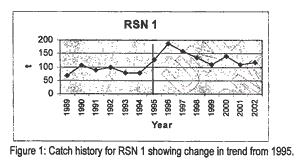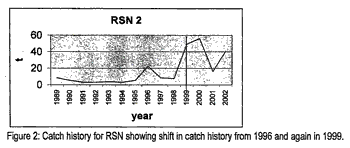|
Submission
The
Northern Inshore Fisheries Company Ltd
26
February 2004
The
Northern Inshore Fisheries Company Limited |
PO
Box 492 |
Auckland |
26 February 2004
Emma Knight
Ministry of Fisheries
P O Box 1020
WELLINGTON
Dear Emma
Introduction of
New Species into the Quota Management System on 1 October 2004.
This submission is made by the Northern
Inshore Fisheries Company Ltd (TNIFCL) in response to the Ministry
of Fisheries consultation document on the proposed management frameworks
for fishstocks gazetted for introduction into the QMS on 1 October
2004. The comments in this submission are based on:
- Consultation with key TNIFCL stakeholders
- TNIFCL's analysis of the consultation document
- Evaluation of the New Zealand Seafood Industry Council's submission.
TNIFCL thank you for the
opportunity to provide comment on the consultation document. This
submission focuses primarily on those species specifically relevant
to TNIFCL. These species are:
- Kahawai
- Parore
- Porae
- Red snapper
The TNIFCL opinion on each
species will be given separately.
Kahawai
TNIFCL supports the setting
of TACs for kahawai under Section 13 of the Fisheries Act (the Act).
TNIFCL endorse the approach
taken not to use the current CCLs as a basis for setting the TACCs
and supports the caution adopted to the use of the historic stock
assessment information. It also supports the view of MFish that
a utility based model is inappropriate for this fishery on the basis
of both uncertain knowledge and the absence of any tradeable rights
between sectors and the reasonable certainty that the fishstock
is above Bmsy at current catch levels. We support the use of catch
history years. In the instance that MFish chose to reconsider a
utility based model then it will need to adopt a different approach
to assigning a value to kahawai as part of a portfolio of seasonal
fishstocks rather than rely on port price information. we would
welcome engagement with MFish on the establishment of a value to
commercial fishers should it be required.
TNIFCL recognises the inherent
problems with the recreational diary surveys and believe that MFish
should qualify any advice to the Minister over the robustness and
acceptance of the presumed recreational catch of each survey.
TNIFCL have significant concerns over
the catch history data provided in the IPP. This differs from the
data used in the MFish Stock Assessment process and in the data
published by Clement. As a solution to the confusion in data on
the kahawai fishery, TNIFCL believe that the catch records used
and approved through the stock assessment process and plenary should
be the basis for setting the TACCs and TACs for all kahawai fishstocks.
This data is listed below for kahawai 1.
| Year
|
KAH1
|
| 1993-94 |
2054 |
| 1994-95 |
1918 |
| 1995-96 |
1904 |
| 1996-97 |
2214 |
| 1997-98 |
1601 |
| 1998-99 |
1833 |
| 1999-00 |
1616 |
| 2000-01 |
1746 |
| 2001-02 |
1208 |
Based on average of the five
years of commercial landings for the period between 1997 and 2002
TNIFCL propose the minimum TACC should be set at 1601 t for KAH1
and not 1480 t as proposed by MFish. Some additional allocation
needs to be made as the stock assessment data does not include estimates
of mislabelled fish, dumped fish or fish landed as bait. Kahawai
has also been a bycatch species and is likely to be under-reported
for other methods than purse seining. This revised figure should
give a better assessment of current utilisation. The TAC and other
allocations should be revised on this basis.
TNIFCL support the removal
of fishing permit conditions relating to the closure of the purse
seine fishery once limits for kahawai have been reached. These are
no longer required following introduction to the QMS.
TNIFCL strongly opposes the
unilateral departure from the deemed values policy framework to
apply a factor of 200% to the port price for deemed values. It fully
endorsee the comments raised in the SeaFIC submission. Kahawai clearly
falls within the "all others" fishstock category and the standard
factor of 75% of the port price should apply to this species. It
should be the responsibility and right of the quota holders to negotiate
with MFish appropriate deemed values to prevent the landing of kahawai
in excess of ACE, in order to protect their property right. An existing
example is the deemed value for SNA1 which was agreed upon by the
quota holders.
TNIFCL are aware that MFish
have concerns over trends in population growth in the Northern areas
and subsequent impact on levels of recreational effort. TNIFCL therefore
believe MFish should show consideration towards constraining recreational
effort through reductions in the daily bag limit and setting a minimum
legal assize for kahawai.
TOP
Parore
TNIFCL support the setting
of TACs for Parore under section 13 of the Act. It agrees to the
use of the catch history years 1993-94 to 2002-03 as a method of
setting the TACC in PAR1. It endorses the inclusion of Parore in
the amateur daily bag limit for North Island recreational fishers
and accepts the inclusion of Parore in the low knowledge fishstock
category for deemed values.
Porae
TNIFCL support the setting
of TACs for Porae under section 13 of the Fisheries Act (the
Act). It agrees to the use of the catch history years 1997-98 to
2002-03 as a method of setting the TACC in POR1. It endorses the
inclusion of Porae in the amateur daily bag limit for North Island
recreational fishers and accepts the inclusion of Porae in the low
knowledge fishstock category for deemed values.
Red
snapper
TNIFCL support the setting
of TACs for red snapper under section 13 of the Act.
In its earlier submission
on the introduction of red snapper into the QMS, TNIFCL supported
the inclusion of this fishstock as it believes that there is a development
potential for this fishery. We are disappointed that MFish have
failed to make consideration for the future utilisation of this
fishery. The initial TACs proposed by MFish are not providing for
opportunity for development of the fishery or more some level of
initial development as an incentive for the industry to invest in
the collection of additional information of the impacts of fishing
on the stock through adaptive management programmes or fishery plans.
We wish to make the following points:
The biology and abundance
of the red snapper is not well understood however it is known that
as well as a reef habitat this species is also relatively commonly
found in open water much like snapper (Pagrus auratus) which allows
for open water migration and replacement of populations as well
as the slower reef fish larval replacement. This would indicate
that the population could sustain higher levels of catch than reef
habitat restricted species.
Anecdotal evidence from commercial
fishers is that red snapper are not uncommon in open water habitats
between 100m to 400m. They are caught as bycatch in trawl in open
space above stony ground and by longline in open areas. This would
support the observations that red snapper is not a reef habitat
restricted species.
There appears to be strong
concern that increase in TACC would result in an increase in set
net activity on northern reefs. The industry intent is to develop
the fishery through longline and trawl methods over existing grounds
as such it is unlikely that there would be significant increase
in set net activity on reefs as a result of introduction of this
species into the QMS.
TNIFCL dispute the selection
of catch years for the averaging of current catch and question why
catch data from the 2002-03 fishing year have not been included
in the consideration of catch history as with Parore and Porae.
The data provided through MFish give the catch for RSN1 in 2002-03
as 11.8 tonnes and for RSN2 as 41.2 tonnes. If the full catch history
is plotted for RSN1 (Figure 1) then it is clearly apparent that
there was a significant shift in average catch history from 1995-96
onwards as the fishery began development. TNIFCL believe that the
period 1995 to 2002 is more representative of current catch levels
and should be used for setting the TACC. The average of this period
is 135 t rather than 125 t based on 1993 to 2002 catch history years
and that the TAC and other allocations should be adjusted accordingly.
 |
For RSN2 a similar significant
shift is seen in 1996 (Figure 2) followed by a further increase
in 1999 as the fishery started development. TNIFCL believe that
a more accurate estimate of recent catch history is derived at an
average of the fishing years 1999 to 2002. On this basis TNIFCL
believe the TACC should be a minimum of 40 tonnes rather than 19
tonnes, and that the TAC and other allocations should be adjusted
accordingly.
 |
TNIFCL
endorse the inclusion of red snapper in the combined multi-species
bag limit set at 20 finfish per day.
TNIFCL question
the inclusion of red snapper in the "all other fishstocks" category
for deemed values on the basis that it is inconsistent with the
decisions for setting deemed values for Parore and Porae. TNIFCL
believe that red snapper should be included in the low knowledge
fishstock category.
TNIFCL would
be happy to discuss any of these issues with MFish in more detail.
Yours sincerely
Kate Bartram
Executive
Officer
The Northern
Inshore Fisheries Company Ltd
Email: bartramk@seafood.co.nz
|



